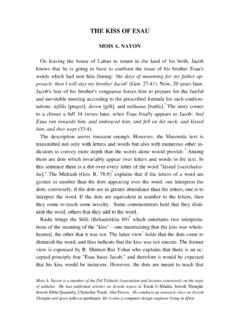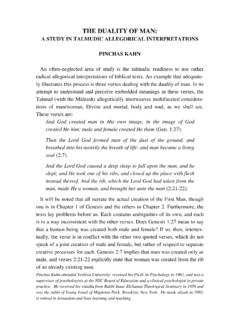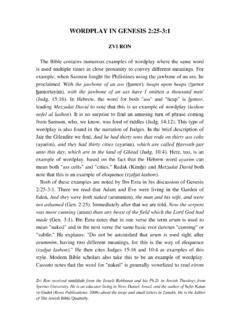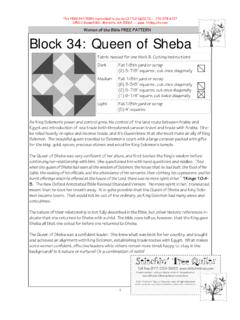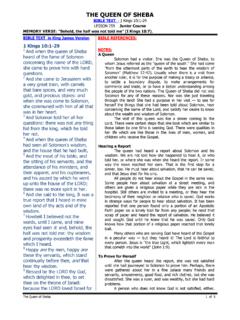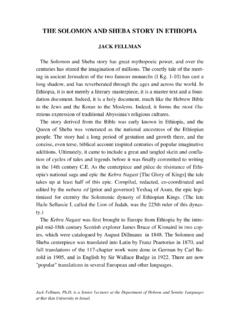Transcription of A QUEEN OF EGYPT AND ETHIOPIA? ELLIOTT A. GREEN
1 ELLIOTT A. GREEN , born in Philadelphia, has an in political science, and also studies histo-ry and Romance languages. He now lives in Jerusalem, working as a translator, researcher and writer. He has published in The Jewish Bible Quarterly and elsewhere. THE QUEEN OF SHEBA: A QUEEN OF EGYPT AND ethiopia ? ELLIOTT A. GREEN Josephus clearly identifies the QUEEN who visited Solomon as "the woman who ruled EGYPT and ethiopia ," and tells us that her name was Yet the Bible calls her the QUEEN of Sheba (I Kg. 10; II Chr. 9). However, else-where in Josephus' Antiquities, he identifies Saba (Sheba) as the Ethiopian capital. He writes "Saba, that was the capital city of the Ethiopians -- its name was subsequently changed to Mero by Cambyses.
2 "2 Ancient Mero is a known location down the Nile from Khartoum. This identification further helps to confirm Josephus' statement about the QUEEN who visited Solomon, since we know of Egyptian conquests in ethiopia . At this point we should recall that the "Aethiopia" of ancient Greek and Latin writings like Kush, its equivalent in biblical Hebrew, Egyptian, Assy-rian, Persian and other languages. was not the ethiopia of today. Aethi-opia/Kush was first of all the northern Sudan of today, as far north as Aswan (the biblical Sweneh), sometimes called Syene in English. This site, at the First Cataract of the Nile, marked the usual southern border of EGYPT (see Ezek.)
3 29:10). The geographic scope of Aethiopia/Kush was sometimes ex-tended to all lands south of the Sahara or inhabited by black people, especial-ly in East Africa. In Byzantine times, Aethiopia in the narrow sense was often called Nubia after a local tribe. Another support for Josephus' identifications of the QUEEN of Sheba with a QUEEN of EGYPT and ethiopia , and of Sheba itself with Mero in Nubia, comes in Genesis 10:7. Here, Sheba is presented as a grandson of Kush. Further, if Seba, a son of Kush (Gen. 10:7), can be identified with Sheba, then the con-nection of Sheba with ethiopia is further strengthened. Josephus' identifica-tion of the QUEEN of Sheba as "the woman who ruled EGYPT and ethiopia " is supported by his identification of the Ethiopian capital as Saba, which is the same as the name of the southern Arabian kingdom conventionally considered the QUEEN 's domain.
4 ELLIOTT A. GREEN JEWISH BIBLE QUARTERLY All this notwithstanding, it has long been commonplace in biblical studies and still is to identify the QUEEN of Sheba whose visit to King Solomon is described in the Bible as the QUEEN of Saba in southern Arabia, an identifica-tion that was already common in the early 18th century when the works of Josephus were translated into English. His information about the QUEEN is usually simply ignored, even by those who choose to accept his statements as authoritative on most other subjects. The author of the article on "Sheba" in the respected Hebrew-language Entsiklopedya Miqra'it [Biblical Encyclope-dia] seems unaware of Josephus' mention of Saba, or perhaps considered it unimportant.
5 Modern scholars often totally overlook what Josephus reported on the identity of the QUEEN and the location of Sheba. The identification of Sheba with the Arabian Saba is accepted by both biblical scholars and Arabists, as well as by archeologists who worked in southern Arabia. They typically assert that the QUEEN came from the Arabian Saba, although she is depicted in the Bible as a wealthy and important monarch, and it should be obvious that one cannot compare the Arabian Saba to EGYPT in wealth or importance. Yet the identification of an Arabian Saba has its supporting arguments too. 1. Sheba is presented in two places in Genesis as a descendant of Shem and within an Arabian context (10:28, 25:3; see also I Chr.)
6 1:22, 1:32). 2. There was no reigning QUEEN in EGYPT at the time of Solomon's reign (ca. 965-925), according to the conventional dating of Egyptian history. 3. The Quran (Sura 27:22-44) narrates a tale of a QUEEN of Saba who vi-sited Solomon; Arab-Muslim tradition identifies her with a "Bilkis" or "Bal-kis" who was supposedly the QUEEN of Saba in southern Arabia. 4. The Arabian Saba, a country rather than a city, was important in the over-land trade across Arabia of goods from southern Arabia and from India. So-lomon, too, was involved in trade in the general direction of southern Arabia and the Indian Ocean (I Kg. 9:26-28, 10:11; II Chr. 8:17-18, 9:10). If Solo-mon's "Tarshish fleet" sailed for Indian Ocean shores, as some believe, rather than the Western Mediterranean, then we would also cite I Kings 10:22 and II Chronicles 9:21.
7 Some think that the QUEEN 's trip was meant to deal with commercial issues. THE QUEEN OF SHEBA Vol. 29, No. 3, 2001 Now the issue of an Arabian Saba versus an Ethiopian (Nubian) Saba can-not be resolved in a brief article. But let us consider some of the arguments for and against an Arabian Saba. 1. The family tree of Sheba in Genesis in an Arabian context is offset by the family tree in an Ethiopian setting. (There are two lines of descent shown in an Arabian context, but these are quite similar.) Why should one lineage be considered more reliable than the other? 2. The Seba (or S'ba) who appears in Genesis 10:7 as a son of Kush turns up in Isaiah 43:3 and 45:14 in settings together with EGYPT and Kush.
8 In the New Jewish Publication Society version, the text of Isaiah, unlike that of Ge-nesis, renders this Seba as Saba (in the form of Sabaites in Isaiah 45:14). Now Seba and Saba are close enough to Sheba to justify seeing them as extremely closely related, if not as one. Saba is of course the name of the Arabian coun-try conventionally identified with Sheba, and it is also the name of the Ethio-pian capital city as given by Josephus, who wrote in Greek. In the genealogies of Genesis, Seba only appears as a son of Kush. Seba turns up again in Psalms 72:10 in a context with Sheba. 3. A tradition recorded in the classic Ethiopian chronicle Kebra Nagast [Glory of Kings] tells of the QUEEN of Sheba as an Ethiopian QUEEN named Makeda, whose child by Solomon became the ancestor of Ethiopian dynas-ties.
9 This is why the royal epithet of modern Ethiopian emperors was Lion of Judah. Why should the Arab tradition of Bilkis be accepted as factual over the Ethiopian tradition? 4. Not even the Quran gives a firm identification of the realm of Sheba as an Arabian place. Indeed, it describes the people of Sheba as sun-worshippers (Sura 27:24). Sun-worship was known in EGYPT . In particular, Akhenaten, a Pharaoh of the XVIIIth Dynasty, was a sun-worshipper. On the other hand, archeologists have excavated a temple to the moon at Marib, the Sabaean capital in southern Arabia. To be sure, the names of several other deities including a sun god have been found in inscriptions in the Saba area, but there is no reported indication that any one of them, including the sun deity, was the principal deity of the Sabaean kingdom, let alone the sole More significant, perhaps, is that the Quran's account of the QUEEN of Sheba is in fact a retelling of tales about her given in the Jewish Midrash with the ELLIOTT A.
10 GREEN JEWISH BIBLE QUARTERLY addition of Muslim coloring and modification of some details. Thus, the Qu-ran's account of the QUEEN is not independent and relies on Jewish The Arab-Muslim tradition (outside the Quran and in commentary on the Quran) about Solomon and the QUEEN of Sheba also depends on Jewish ag-gadah, although less so. Here the story line is drastically changed to have Solomon traveling in Yemen, where he learns of the QUEEN 's existence and summons her. Many less central details have been added too, such as the in-dication of Sheba's (= Saba's) location in southern Arabia and the name Bilkis for the QUEEN . This is the sole ancient source for these two The abundant inscriptions found in the area of Saba and its capital Marib do not mention a QUEEN Bilkis nor any voyage by a QUEEN to Solomon, although other monarchs are mentioned by name.





